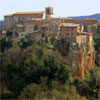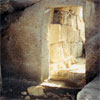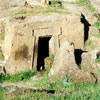|
itineraries
etruscan rock tombs 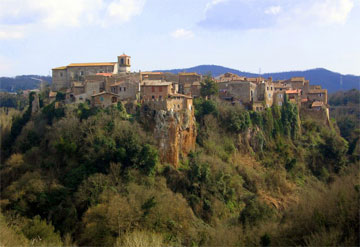 Highlights Terrain: rolling hills with orchards, farms, and pastureland on a stratum of tufo (solidified volcanic mud and ash), here and there dissected by sudden deep gorges with rushing streams, lush vegetation, dramatic cliffs and promontories. Of interest: Etruscan carved and/or painted tombs that are artistic masterworks; eerie Etruscan road cuttings slashed deep in the tufo; the Roman Via Clodia with two bridges; picturesque medieval towns with wonderful traditional dining establishments. History In the eighth century BC the Etruscans began trading with the Greeks on a large scale, and learned to write from them. A wealthy aristocracy emerged, and powerful city-states with paved streets, sewers, palaces and public buildings. Their carved rock tombs often echo details from long-vanished structures. Over a period of many centuries they were defeated and absorbed by the Romans, who built the Via Clodia to administer this part of the territory, primarily by piecing together bits of Etruscan roads and paving them. In the tumultuous Middle Ages many populations returned to the old Etruscan sites which had good natural defenses. “Walking on a road once busy with imperial soldiers and ambushing etruscans, or a bridge that’s been standing for two thousand years…is an experience of satisfying pathos…” Justin Bradshaw
Barbarano Romano
The Route The villages of Barbarano Romano and Blera perch on rocky spurs above deep, converging gorges, as Etruscan towns did 2500 years ago. Nearby we find cliffs with hundreds of astonishing carved tombs, and eerie slashes in the rock where ancient roads still descend into the canyons. Between the towns we traverse the Biedano gorge – a lush oasis with caves and ruined water mills. Two Roman bridges stand along the Via Clodia near Blera. North of Blera the Clodia skirts a massive carved tumulus at Grotta Porcina, then enters the monumental tomb complex of Norchia – perhaps Italy’s most stunning cliff necropolis. On our final day we visit the famous painted tombs of Tarquinia, and dine in the piazza of the elegant walled town of Tuscania. 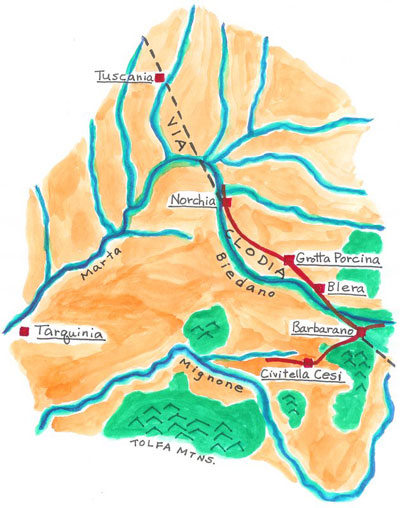 |
| © David Morton 2005 All rights reserved pixelmap |
